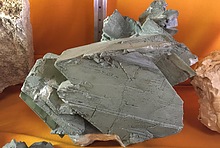Learning CenterWhat is a mineral?The most common minerals on earthInformation for EducatorsMindat ArticlesThe ElementsThe Rock H. Currier Digital LibraryGeologic Time
搜索矿物的性质搜索矿物的化学Advanced Locality Search随意显示任何一 种矿物Random Locality使用minID搜索邻近产地Search Articles搜索词汇表更多搜索选项
╳Discussions
💬 Home🔎 Search📅 LatestGroups
EducationOpen discussion area.Fakes & FraudsOpen discussion area.Field CollectingOpen discussion area.FossilsOpen discussion area.Gems and GemologyOpen discussion area.GeneralOpen discussion area.How to ContributeOpen discussion area.Identity HelpOpen discussion area.Improving Mindat.orgOpen discussion area.LocalitiesOpen discussion area.Lost and Stolen SpecimensOpen discussion area.MarketplaceOpen discussion area.MeteoritesOpen discussion area.Mindat ProductsOpen discussion area.Mineral ExchangesOpen discussion area.Mineral PhotographyOpen discussion area.Mineral ShowsOpen discussion area.Mineralogical ClassificationOpen discussion area.Mineralogy CourseOpen discussion area.MineralsOpen discussion area.Minerals and MuseumsOpen discussion area.PhotosOpen discussion area.Techniques for CollectorsOpen discussion area.The Rock H. Currier Digital LibraryOpen discussion area.UV MineralsOpen discussion area.Recent Images in Discussions
Mineralogical ClassificationGabrielite: type-description abstract
1st May 2006 21:04 UTCMarco E. Ciriotti Manager
• Graeser, S., Topa, D., Balić-Žunić, T., Makovicky, E. (2006): Gabrielite, Tl2AgCu2As3S7, a new species of thallium sulfosalt from Lengenbach, Binntal, Switzerland. Canadian Mineralogist, 44, 135-140.
Abstract:
Gabrielite, Tl2AgCu2As3S7, is a new species of sulfosalt mineral occurring in the famous Lengenbach locality, at Binntal, Canton Valais, Switzerland. It was discovered in association with numerous other As sulfosalts, such as hutchinsonite, hatchite, edenharterite, trechmannite, tennantite, and abundant realgar and rathite, generally occurring as idiomorphic crystals in cavities of a Triassic dolomitic rock. The whole region was transformed during the Alpine orogeny to the greenschist to garnet-amphibolite facies of metamorphism. Gabrielite occurs as pseudohexagonal crystals; its true symmetry is triclinic, space group P¯1, Z = 6, a 12.138(3), b 12.196(3), c 15.944(4) Å, a 78.537(5), b 84.715(4), g 60.470(4)°, V 2013(1) Å3 (from the crystal-structure determination). The strongest powder-diffraction lines are 15.63(100)(001), 3.143(90)(21¯4, 1¯14), 3.531(80)(300), 2.911(70)(422, 2¯1¯4), 2.520(60)(2¯23), and 2.978(60)(324). Gabrielite is opaque with a grey to black color, metallic luster and blackish red streak. Individual crystals reach up to approximately 0.4 mm, and aggregates may exceed 1 mm across. Euhedral crystals are short prismatic to platy parallel to (001), with excellent cleavage along this face. The microhardness VHN,18 kg/mm2 (load 10 g), corresponds to a Mohs hardness of 1½–2. The chemical composition (electron microprobe, mean result of 11 analyses, in wt%) is Tl 37.30, Cu 12.50, Ag 8.47, As 18.90, Sb 1.79, S 20.64, total 99.70 wt%, from which the empirical formula, Tl5.95(Ag2.56Cu6.46)S9.02(As8.23Sb0.48)S8.71S21, was derived. The simplified formula is Tl2AgCu2As3S7. The calculated density Dcalc is 5.38 g/cm3. In reflected light, gabrielite is white, has common red internal reflections, shows weak anisotropy and moderate reflectivity <%Rmax in air (COM wavelengths in nm)>: 30.53(470), 29.10(546), 27.94(589), 26.35(650). The crystal structure is layered parallel to (001), which explains the habit and cleavage. The twin law with (100) as a twin plane is due to the local symmetry properties of the structural layers. A presence of metal–metal (Tl–Tl and Tl–Cu) and metal–semimetal (Tl–As) bonds in the structure explains the low hardness and metallic character. Substitutions of Cu for Ag in the tetrahedral coordinations, Ag for Cu in the trigonal–planar coordinations, and Sb for As in isolated AsS3 coordination polyhedra and As4S8 rings lead to the structural formula Tl6(Ag,Cu)3IV(Cu,Ag)6III<(As,Sb)S3>3<(As,Sb)2S4>3; the empirical formula obtained from the microprobe data is Tl5.95(Ag2.56Cu6.46)S9.02(As8.23Sb0.48)S8.71S21. The name of the mineral honors Walter Gabriel, of Basel, Switzerland, well-known mineral photographer and expert of Lengenbach minerals.
1st May 2006 21:09 UTCMarco E. Ciriotti Manager
• Balić-Žunić, T., Makovicky, E., Karanović, L., Poleti, D., Graeser, S. (2006): The crystal structure of gabrielite, Tl2AgCu2As3S7, a new species of thallium sulfosalt from Lengenbach, Switzerland. Canadian Mineralogist, 44, 141-158.
Abstract:
The crystal structure of gabrielite has been refined using single-crystal data (X-ray diffraction, MoKa, CCD area detector) to a conventional R-factor R1 of 0.0486. It crystallizes in space group P¯1, with a 12.138(3), b 12.196(3), c 15.944(4) Å, a 78.537(5), b 84.715(4), g 60.470(4)° and Z = 2. The chemical formula obtained from the structure analysis is Tl6Ag2.61Cu6.39As8.55Sb0.45S21, in good accordance with the results of the chemical analysis. It can be represented as Tl6(Ag,Cu)3IV(Cu,Ag)6III(As,Sb)9S21, where IV denotes the tetrahedral, and III the trigonal planar coordinations. There are both isolated AsS3 pyramidal groups and those forming four-membered rings. The Tl atom shows various coordinations, from trigonal prismatic and antiprismatic to square antiprismatic, and more complex arrangements with coordination numbers 7 and 9. A characteristic feature is the presence of many short contacts between those of Tl atoms, which have more strongly expressed lone-electron pair activity, and Cu atoms (Tl–Cu in the range 3.03–3.08 Å). There is also a short Tl–Tl contact of only 3.09 Å between atoms in flattened trigonal antiprismatic coordination. The same Tl atoms exhibit short Tl–As distances (3.11 Å) across the lone pairs of electrons of As. This Tl coordination is of the same type as that found in Li5Tl2. These are the shortest Tl–Cu, Tl–Tl and Tl–As contacts recorded in sulfosalts so far. The crystal structure is layered, with two types of sulfur layers, one with the 34.6 mesh, and the other composed of triangles, squares and pentagons with idealized plane-symmetries p3 and p31m, respectively. The coordination polyhedra of cations form three main slabs, two with the idealized plane-symmetry P¯3 and one with C2/m symmetry. One of the two pseudotrigonal slabs is the starting member of a hypothetical homologous series of cyclically twinned sulfosalt structures. Internal symmetries of the slabs lead to a twin law with (100) as the twin plane, and make possible the existence of several potential OD polytypes.
2nd May 2006 15:09 UTCPeter Haas




版权所有© mindat.org1993年至2024年,除了规定的地方。 Mindat.org全赖于全球数千个以上成员和支持者们的参与。
隐私政策 - 条款和条款细则 - 联络我们 - Report a bug/vulnerability Current server date and time: 2024.4.24 12:01:09
隐私政策 - 条款和条款细则 - 联络我们 - Report a bug/vulnerability Current server date and time: 2024.4.24 12:01:09











